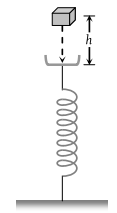The potential energy of a body is given by, U = A – Bx2 (Where x is the displacement). The magnitude of force acting on the particle is
(1) Constant
(2) Proportional to x
(3) Proportional to x2
(4) Inversely proportional to x
A 0.5 kg ball is thrown up with an initial speed 14 m/s and reaches a maximum height of 8.0m. How much energy is dissipated by air drag acting on the ball during the ascent
(1) 19.6 Joule
(2) 4.9 Joule
(3) 10 Joule
(4) 9.8 Joule
A block of mass m initially at rest is dropped from a height h on to a spring of force constant k. The maximum compression in the spring is x then-

(1)
(2)
(3)
(4)
1. \(7.46~\text{J}\)
2. \(7400~\text{J}\)
3. \(7.46~\text{ergs}\)
4. \(74.6~\text{J}\)
An engine pumps up 100 kg of water through a height of 10 m in 5 s. Given that the efficiency of the engine is 60% . If g = 10 ms–2, the power of the engine is
(1) 3.3 kW
(2) 0.33 kW
(3) 0.033 kW
(4) 33 kW
An engine pump is used to pump a liquid of density ρ continuously through a pipe of cross-sectional area A. If the speed of flow of the liquid in the pipe is v, then the rate at which kinetic energy is being imparted to the liquid is
(1)
(2)
(3)
(4)
The kinetic energy acquired by a mass m in travelling a certain distance d starting from rest under the action of a constant force is directly proportional to
(1)
(2) Independent of m
(3)
(4) m
An open knife edge of mass 'm' is dropped from a height 'h' on a wooden floor. If the blade penetrates upto the depth 'd' into the wood, the average resistance offered by the wood to the knife edge is
(1) mg
(2)
(3)
(4)
The pointer reading v/s load graph for a spring balance is as given in the figure. The spring constant is-
(1) 0.1 N/cm
(2) 5 N/cm
(3) 0.3 N/cm
(4) 1 N/cm
A particle which is constrained to move along the x-axis, is subjected to a force in the same direction which varies with the distance x of the particle from the origin as . Here k and a are positive constants. For , the functional form of the potential energy U(x) of the particle is-
(1)
(2)
(3)
(4)











